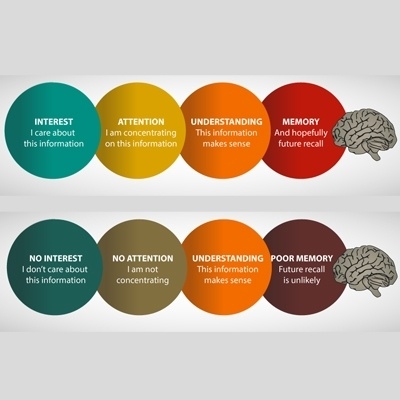Why eLearning Should Never Be Compulsory
Compulsory eLearning is bad idea. The last time I agreed to try it, we made attendance at a webinar compulsory for around 2,000 staff. The final attendance rate was 24%.
I think making eLearning compulsory is almost always counter-productive and reduces the effectiveness of the learning solution. Here are four reason why:
- eLearning doesn't work for everyone
Different people learn in different ways. Some people like a self-paced, computer based approach. But other people prefer face-to-face conversations. Some people are more comfortable with technology than others. And sometimes people don’t have the infrastructure available to run large, complex eLearning modules (e.g. if they are in a remote location).eLearning should never be the only way for people to learn. It should be one option in a range of options. The more variety you can deliver, the better the likelihood that each person can find a learning method that works for them. - Adult learners like to direct their own learning
Children get told what to do. Grown-ups get to choose for themselves. Telling someone else they "must" do something can make them feel like a child. The negative perception generated by this "must" message can detract from, or damage, the messages in your eLearning solution. - Ensuring compliance is problematic
If you have a lot of influence with your audience, when you tell them they “must” do your eLearning a lot of them will. But if you don’t have that much influence (and often you won’t) you will need some way to track who has done the eLearning; and then follow up with those that have not. Which can be a logistical and administrative nightmare; especially in a big organisation. First off, how clear are you on who must do the training. Just full-time employees, or part-timers too? How about people who don’t work on the front line? What about senior managers? You need to define your target audience very well. Secondly, how will you know if the eLearning is completed? Is simply reaching the end enough, or do you need a quiz? What would the pass mark be? Does it need to be the same for everyone? Surely a senior manager can’t be expected to get the same mark as someone who does this every day! Thirdly, who is going to be responsible for tracking who has completed the training and following up with the non-completers? It should ideally be someone who has some authority over that person, but do you really want to add more workload to their manager? What if the manager doesn't feel a need to make their staff complete your training? Then what do you do?As you can see, there are a lot of details that you need to sort out. The alternative would be to simply not track completion. But if you do that, your audience will learn that they do not need to pay attention when you say something is important. And that will make any future learning solutions harder to implement. - You turn your solution into a 'tick the box' exercise
You can force someone to do your training, but you cannot force them to learn. If your criteria for completion is reaching the last slide, some people will just click the Next button. If your criteria for completion is passing a quiz, inevitably someone will tell their workmates the answer. Or your students will just guess until they guess correctly.
4 Alternative Solutions To Compulsory eLearning
So what's the alternative? You really want people to understand your message. It's important - even if most people won't be able to see how straight away. Don't worry - there is hope. Here are my suggestions to keep your solution effective without making it compulsory:
- Make sure you know the benefits
WHY should people do this eLearning? Make sure you have good, solid reasons. And make sure those reasons are relevant to your audience. This last point is crucially important if you want people to voluntarily complete your learning. For example "we're doing this Workplace Health & Safety training because it's a legislative requirement". As a learner it isn't a good enough reason for me to engage with the content. But "did you know our organisation had 235 WH&S incidents last year, and we're committed to getting better this year" gives me something more tangible. And "if there is ever a fire you really need to know this to survive" is always a good enticement. - Beef up your promotional activities
Send out communications before you release your eLearning that explain why it is important and what people will gain from doing it. Try to generate some buzz.Speak at regional or divisional meetings. Try to encourage managers, especially senior managers, to promote your solution. Advertise on your intranet, on your LMS, in other training, or wherever else you can think of.If you have access to a Change Management specialist who can help you out, approach them for help. They will have the best ideas on stakeholder management and effective communications. - Have interesting eLearning (and make sure people know it's interesting)
It sounds obvious doesn't it? But in my experience the eLearning where the "let's make it compulsory" suggestion comes up is often the eLearning that is ... well ... a bit boring. It's the workplace health and safety, the policy and process changes, the legislative record-keeping obligations. It's very easy to whack out a quick eLearning solution on these types of topics, but much harder to come up with an engaging, entertaining module. And if you're not willing to put in the time on design and development, don't expect your audience to put in the time to complete the training. - Have alternatives
Remember, not everyone likes eLearning, and that's OK. At the very least, have some printable resources for those that like something they can physically touch and store. Consider some form of human interaction. Face-to-face training might not be an option; but there are always webinars, phone support lines, follow-ups in team meetings, scheduled drop-in sessions, and floor walkers. A little bit of interaction with a real person will go a long way to embedding your learning.Always have some way for people to ask questions. This doesn't have to be one of the face-to-face options. It could be through an online feedback form that you monitor. Or maybe your Learning Management System or website has a chat or forum feature. At the very least give people an email address that they can send questions to.
Above all else, remember that your objective is learning, not training. Training is a once-off event; but learning takes time.
Originally published on October 29, 2013









